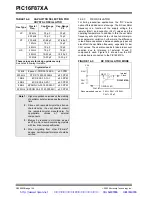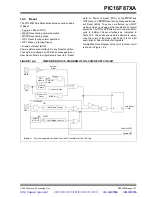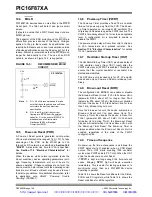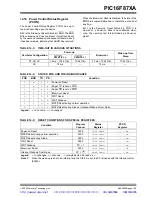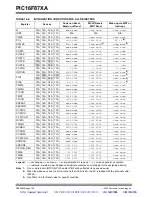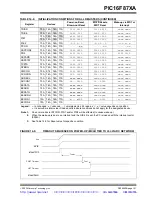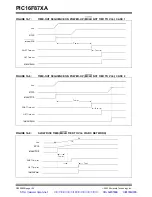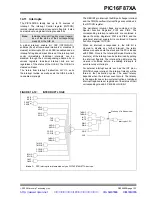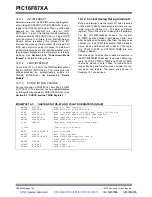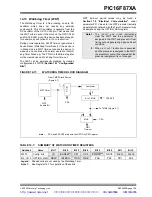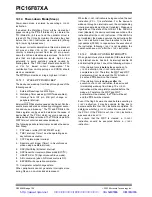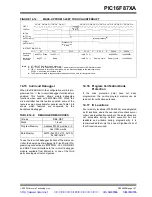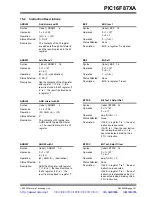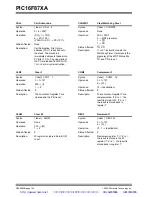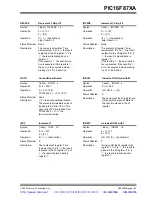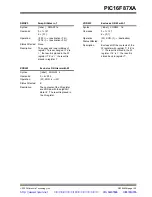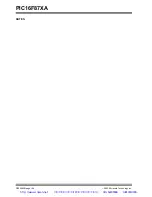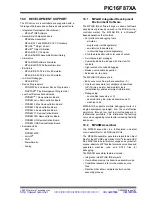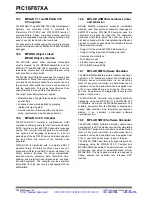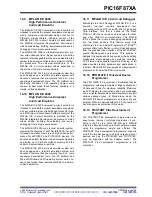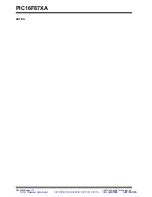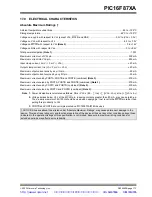
PIC16F87XA
DS39582B-page 158
2003 Microchip Technology Inc.
14.18 In-Circuit Serial Programming
PIC16F87XA microcontrollers can be serially pro-
grammed while in the end application circuit. This is
simply done with two lines for clock and data and three
other lines for power, ground and the programming
voltage. This allows customers to manufacture boards
with unprogrammed devices and then program the
microcontroller just before shipping the product. This
also allows the most recent firmware or a custom
firmware to be programmed.
When using ICSP, the part must be supplied at 4.5V to
5.5V if a bulk erase will be executed. This includes
reprogramming of the code-protect, both from an on
state to an off state. For all other cases of ICSP, the part
may be programmed at the normal operating voltages.
This means calibration values, unique user IDs or user
code can be reprogrammed or added.
For complete details of serial programming, please
refer to the “PIC16F87XA Flash Memory Programming
Specification” (DS39589).
14.19 Low-Voltage (Single-Supply)
ICSP Programming
The LVP bit of the configuration word enables low-
voltage ICSP programming. This mode allows the
microcontroller to be programmed via ICSP using a
V
DD
source in the operating voltage range. This only
means that V
PP
does not have to be brought to V
IHH
but
can instead be left at the normal operating voltage. In
this mode, the RB3/PGM pin is dedicated to the pro-
gramming function and ceases to be a general purpose
I/O pin. During programming, V
DD
is applied to the
MCLR pin. To enter Programming mode, V
DD
must be
applied to the RB3/PGM provided the LVP bit is set.
The LVP bit defaults to on (‘
1
’) from the factory.
If Low-Voltage Programming mode is not used, the LVP
bit can be programmed to a ‘
0
’ and RB3/PGM becomes
a digital I/O pin. However, the LVP bit may only be pro-
grammed when programming is entered with V
IHH
on
MCLR. The LVP bit can only be charged when using
high voltage on MCLR.
It should be noted, that once the LVP bit is programmed
to ‘
0
’, only the High-Voltage Programming mode is
available and only High-Voltage Programming mode
can be used to program the device.
When using low-voltage ICSP, the part must be supplied
at 4.5V to 5.5V if a bulk erase will be executed. This
includes reprogramming of the code-protect bits from an
on state to an off state. For all other cases of low-voltage
ICSP, the part may be programmed at the normal oper-
ating voltage. This means calibration values, unique
user IDs or user code can be reprogrammed or added.
Note 1: The High-Voltage Programming mode is
always available, regardless of the state
of the LVP bit, by applying V
IHH
to the
MCLR pin.
2: While in Low-Voltage ICSP mode, the
RB3 pin can no longer be used as a
general purpose I/O pin.
3: When using Low-Voltage ICSP Program-
ming (LVP) and the pull-ups on PORTB
are enabled, bit 3 in the TRISB register
must be cleared to disable the pull-up on
RB3 and ensure the proper operation of
the device.
4: RB3 should not be allowed to float if LVP
is enabled. An external pull-down device
should be used to default the device to
normal operating mode. If RB3 floats
high, the PIC16F87XA device will enter
Programming mode.
5: LVP mode is enabled by default on all
devices shipped from Microchip. It can be
disabled by clearing the LVP bit in the
CONFIG register.
6: Disabling LVP will provide maximum
compatibility to other PIC16CXXX
devices.
http://www.xinpian.net
提供单片机解密、IC解密、芯片解密业务
010-62245566 13810019655



